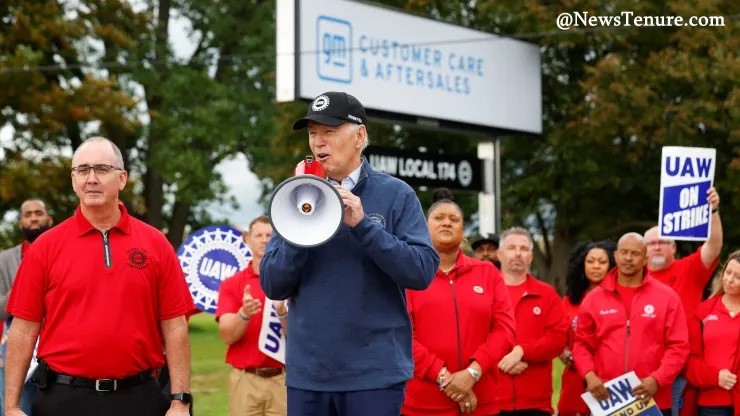DOWNTOWN — After hard talks and over six weeks of labor strikes against the Detroit manufacturers, the United Auto Workers and General Motors reached a provisional agreement on Monday.
Before the negotiations, UAW President Shawn Fain warned of a more militant union, but few, if any, anticipated the union would outmaneuver the corporations in such a way, resulting in record settlements for 146,000 UAW workers with GM and Ford Motor.
plus Stellantis.
..
The finalized settlements, the specifics of which are still being worked out, set 25% compound annual increases throughout the four and a half-year agreements. These increases included an 11% boost upon ratification, the resumption of cost-of-living adjustments, higher business contributions to 401(k) plans, and improved profit-sharing bonuses.
The tentative agreements need to be ratified by UAW members through a vote. Before members can vote on the agreements, local union leaders must also accept the GM and Stellantis deals.
At the conclusion of the negotiations, Fain and the union are the obvious winners, but other parties like Tesla and President Joe Biden might also benefit. Therefore, the automakers and possibly their investors as well as any aspirations for electric vehicles are counted among the losers.
“This has a lot of winners.” Thus, the UAW members rank first, naturally,” stated Art Wheaton, a labor expert at Cornell University’s The Worker Institute. It exceeded my expectations and my sense of what was achievable by far. It’s a triumphant hit.
Winner: Shawn Fain
Fain established himself as the union’s spokesperson during the negotiations, successfully drawing attention to the union’s talks with the Detroit automakers across the country by adopting a variety of talking points, including workers’ rights, fighting against billionaires, and restoring the middle class.
Fain is the face of the win as well, thanks to his harsh speech and regular live updates throughout the process.
The “Big Three” loser
The union’s plan, which included unprecedented, targeted strikes that kept the automakers on edge and helped to give the union influence over the firms, was misjudged by the “Big Three” Detroit automakers and Fain.
As a result, union workers received record-breaking contracts that extracted more value from the corporations than many had predicted before the negotiations began.
According to Ford, the UAW strike lost the company $1.3 billion in earnings before interest and taxes on Thursday. As of last week, GM said that the strike had cost it $800 million.
Natalie Knight, the CFO at Stellates, said on Tuesday that the impact of the UAW strikes on the company’s earnings would probably be comparable to that of GM and Ford, but she would not say how much.
According to a Tuesday business report, Stellantis lost over $3.2 billion (3 billion euros) in revenue as a result of the UAW strikes through October.
Possibility winner: UAW planning
Citing discussions with the “big five or big six” automakers, Fain stated on Sunday that the UAW intends to use these record deals to support its beleaguered organizing efforts, including at auto companies outside of the three Detroit automakers.
In the upcoming years, it will be determined if the UAW can organize foreign automakers in the United States, a practice known as transplants, or electric vehicle companies like Tesla or Rivian.
According to Marick Masters, a business professor at Wayne State University in Detroit, “they have the best chance now that they’ve had over 40 years to organize the transplants and, perhaps, the nonunion electrical vehicle companies.” “But the battle is still steep and uphill.”
Loser Investors
Shares of Ford are down 23% since the targeted attacks started on September 15, GM is down about 19%, and Stellantis is down about 4%.
The extent to which the agreements will raise labor costs for the businesses is unknown at this time. The businesses had claimed that complying with every union demand would harm their ability to compete and possibly even their long-term survival.
According to recent estimates from Deutsche Bank, the agreement will increase costs overall at Ford by $6.2 billion, GM by $7.2 billion, and Stellantis by $6.4 billion over the course of the agreement.
According to Ford, the UAW agreement will increase assembly costs per vehicle by $850 to $900 if members approve it. In order to meet previously stated profitability targets, Ford will seek to “find productivity and efficiencies and cost reductions throughout the company,” according to Finance Chief John Lawler’s statement last week.
Winners (some more than others): UAW members
The UAW members covered by the new agreements are generally winners, but not all of them were spared the financial consequences of the union’s strikes against the Detroit automakers.
Plant strikes were progressively included by the union in its targeted, or “stand-up,” strike strategy. For nearly six weeks, members who participated in the initial strikes or were laid off as a result of the work stoppages were not paid more than $500 per week in strike pay, while others were never asked to stop working.
Employees who work on or after October 23 will receive retroactive pay under the Ford agreement.
Potential loser: Nonunion plants
Automakers such as Tesla, Rivian, Toyota, and Hyundai, among others, may be reconsidering their nonunion plant employee compensation plans.
Due to UAW record victories, these companies run the risk of losing workers to the plants of their Detroit rivals. They might also become the focus of members’ heightened organizing efforts in an attempt to secure better pay comparable to that of UAW members.
“The nonunion companies now have a choice: You either raise your pay and benefits to keep up with what the current rate is for the UAW or you face the chances of getting a union organizer and driving your plans,” Wheaton said. “The UAW has won huge gains at their plants.”
Loser: EVs
Both Ford and GM announced production or investment delays for electric vehicles (EVs) in an effort to counteract rising labor costs and address the lower-than-expected demand for EVs.
Although Ford announced last week that it would postpone $12 billion in planned spending on new EV manufacturing capacity, GM has stated that it will delay at least three models in addition to expanding electric truck production by at least a year in Michigan until late 2025.
Despite making large investments in plug-in hybrid electric cars for the US market, Stellantis has not made any major announcements regarding the future of its EV plans.
“It’s obvious that the union won,” Masters stated. “Businesses will be able to weather both the labor cost increase and the strike. However, I’m not sure if they’ll succeed in the competition for electrical vehicles.
Potential winner: Tesla
With its present and future products, Tesla may have more time to compete in the market if some EVs are released more slowly.
The market share of EV leader Tesla has decreased recently due to increased competition, particularly in the luxury car segment. It was anticipated that the Detroit automakers would increase their competition in the lower-priced models.
It is unclear, according to Masters, whether the Detroit automakers will be able to enter the market with profitable electric vehicles in time to outperform the competition and continue to turn a profit large enough to allow them to survive as stand-alone businesses.
Winner: Biden
In an unprecedented step, Biden chose to support and validate his claim to be the “most pro-union president in American history” by joining UAW members on a picket line.
Although the UAW hasn’t endorsed Biden yet, the backing might eventually persuade the union to do so. Additionally, it might influence Midwest blue-collar voters who will be crucial in the 2024 presidential election.
After meeting with Fain on Monday, Biden praised the UAW’s agreements with the Detroit automakers.
At the White House, Biden stated, “These record agreements reward autoworkers who gave up much to keep the industry working and going during the financial crisis more than a decade ago.” “The Big Three can continue to lead the world in quality and innovation thanks to these agreements.”




